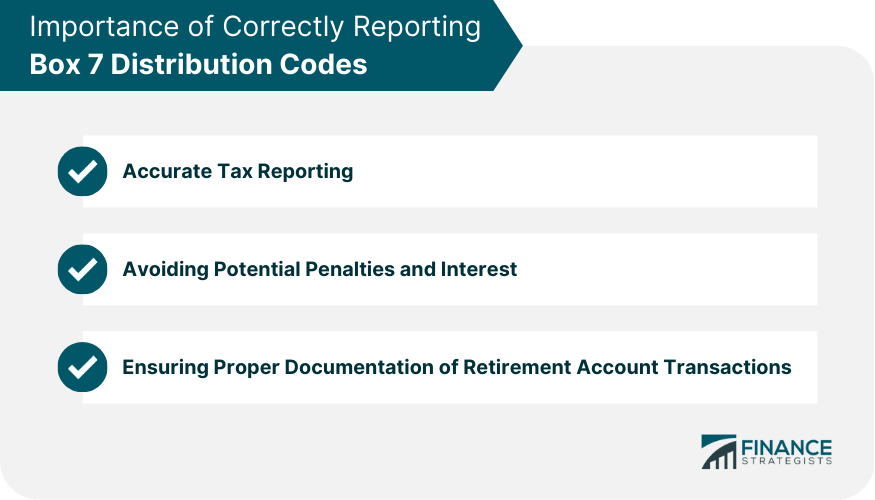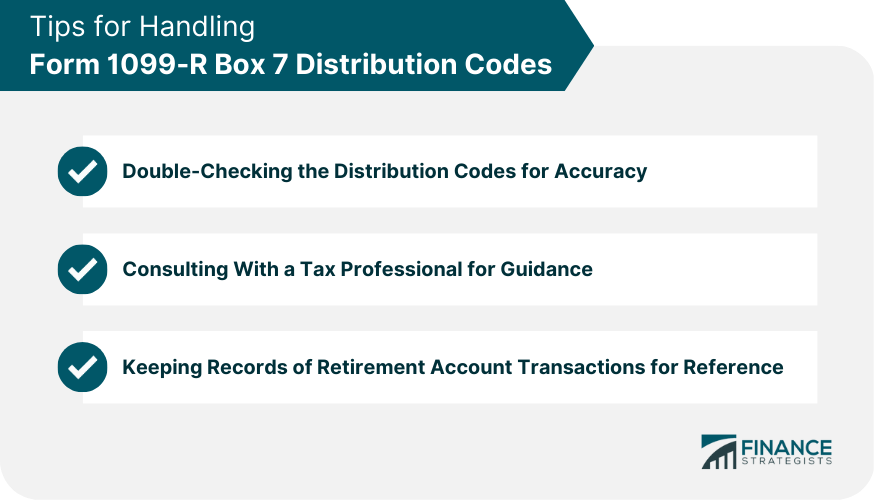Form 1099-R is an IRS tax form used to report distributions from pensions, annuities, retirement plans, profit-sharing plans, and IRAs. Taxpayers who receive distributions from these sources during a tax year must report the income on their tax return. Box 7 on Form 1099-R contains distribution codes that help taxpayers and the IRS understand the nature of the distribution. These codes are essential for accurately reporting the distribution on the taxpayer's tax return and determining the appropriate tax treatment. Accurately interpreting and reporting distribution codes is crucial for ensuring that taxpayers pay the correct amount of tax on their retirement plan distributions and avoid potential penalties and interest. Code 1 indicates an early distribution from a retirement plan or IRA with no known exception. In most cases, this distribution is subject to an additional 10% early withdrawal penalty. Code 2 is used when an early distribution is taken from a retirement plan or IRA, but an exception to the 10% early withdrawal penalty applies. This code is used to indicate a distribution from a retirement account due to the account owner's total and permanent disability. If the account owner qualifies as disabled, they may be exempt from the 10% early withdrawal penalty even if they are under age 59 ½. Code 4 indicates that the distribution was made to a beneficiary after the account holder's death. Depending on the situation, the distribution may be subject to different tax rules and requirements for the beneficiary who receives the distribution. A prohibited transaction violates the rules and regulations governing retirement accounts, such as an IRA or 401(k). Examples of prohibited transactions include using retirement account funds to purchase personal assets or using retirement account funds to provide a loan to a family member. A Section 1035 exchange is a tax-free exchange of an annuity contract or life insurance policy for another annuity contract or life insurance policy. This code is used to report the exchange of one annuity contract or life insurance policy for another, typically between insurance companies. This code is used to indicate a distribution from a retirement account that is a normal distribution, typically made after age 59 ½. Excess contributions exceed the annual contribution limits set by the IRS. For example, in 2024, the annual contribution limit for a traditional or Roth IRA is $7,000 for individuals under age 50 and $8,000 for those aged 50 and over. Code 9 signifies that the distribution represents the cost of current life insurance protection under a retirement plan. Code G indicates that the distribution was a direct rollover from one retirement plan to another, such as from a 401(k) to an IRA. Code J is used when an early distribution is taken from a SIMPLE IRA. This code is used to indicate a qualified distribution from a Roth IRA, which means that the distribution is tax-free and penalty-free. Code R indicates that the distribution represents a recharacterized IRA contribution. Code S is used when an early distribution is taken from a SIMPLE IRA within the first two years of participation. Code T signifies that a distribution from a Roth IRA is subject to an exception to the 10% early withdrawal penalty. Correctly reporting distribution codes is essential for accurately calculating and reporting taxable income on a tax return. Failure to accurately report distribution codes can result in the imposition of penalties and interest by the IRS. Properly reporting distribution codes helps taxpayers maintain accurate records of their retirement account transactions, which can be beneficial in case of an audit or future tax planning. Taxpayers should review their Form 1099-R and ensure that the distribution codes listed in Box 7 accurately reflect the nature of the distributions they received. If taxpayers are unsure about the proper interpretation or reporting of a distribution code, they should consult with a tax professional for guidance. Taxpayers should maintain records of their retirement account transactions, including copies of their Form 1099-R, as these documents can be helpful for future tax planning or in case of an audit. Form 1099-R Box 7 distribution codes are crucial for accurately reporting retirement plan distributions on a taxpayer's tax return. Understanding and properly interpreting these codes ensure that taxpayers pay the correct amount of tax on their distributions and avoid potential penalties and interest. Accurate reporting and understanding of distribution codes also contribute to maintaining precise records of retirement account transactions, which can be beneficial in case of an audit or future tax planning. Given the complexities involved in interpreting and reporting distribution codes, taxpayers are encouraged to consult with a tax professional for assistance. By seeking professional guidance, taxpayers can be confident in accurately reporting their retirement plan distributions on their tax return and navigating the various tax implications associated with these distributions.Form 1099-R Box 7 Distribution Codes: Overview
Common Distribution Codes in Box 7 of Form 1099-R
Code 1: Early Distribution, No Known Exception
Code 2: Early Distribution, Exception Applies
Code 3: Disability
Code 4: Death
Code 5: Prohibited Transaction
Code 6: Section 1035 Exchange
Code 7: Normal Distribution
Code 8: Excess Contributions
Code 9: Cost of Current Life Insurance Protection
Code G: Direct Rollover
Distribution Codes for Specific Retirement Plans
Code J: Early Distribution From a SIMPLE IRA
Code Q: Qualified Distribution From a Roth IRA
Code R: Recharacterized IRA Contribution
Code S: Early Distribution From a SIMPLE IRA in the First 2 Years
Code T: Roth IRA Distribution, Exception Applies
Importance of Correctly Reporting Box 7 Distribution Codes
Accurate Tax Reporting
Avoiding Potential Penalties and Interest
Ensuring Proper Documentation of Retirement Account Transactions

Tips for Handling Form 1099-R Box 7 Distribution Codes
Double-Checking the Distribution Codes for Accuracy
Consulting With a Tax Professional for Guidance
Keeping Records of Retirement Account Transactions for Reference

Conclusion
Form 1099-R Box 7 Distribution Codes FAQs
Form 1099-R Box 7 is a section on the IRS form used to report distributions from retirement accounts, pensions, annuities, and other similar types of plans.
The distribution codes used in Box 7 of Form 1099-R indicate the type of distribution that was made from the account. The codes range from 1 to 7 and include regular distributions, early distributions, and distributions from inherited accounts.
Box 7 on Form 1099-R is important because it determines whether the distribution is subject to income tax, early withdrawal penalties, or other tax consequences.
A common distribution code used in Box 7 of Form 1099-R is code 7, which indicates a normal distribution. This means that the distribution was made after the account holder reached the age of 59 and a half, and is generally not subject to early withdrawal penalties.
Individuals can use the information in Box 7 of Form 1099-R to determine the tax treatment of their retirement plan distributions, and to report the distributions on their tax returns. The distribution codes provide important information about the type of distribution and any tax consequences that may apply. It is important to review Form 1099-R carefully and consult with a tax professional if necessary to ensure that retirement plan distributions are reported accurately on tax returns.
True Tamplin is a published author, public speaker, CEO of UpDigital, and founder of Finance Strategists.
True is a Certified Educator in Personal Finance (CEPF®), author of The Handy Financial Ratios Guide, a member of the Society for Advancing Business Editing and Writing, contributes to his financial education site, Finance Strategists, and has spoken to various financial communities such as the CFA Institute, as well as university students like his Alma mater, Biola University, where he received a bachelor of science in business and data analytics.
To learn more about True, visit his personal website or view his author profiles on Amazon, Nasdaq and Forbes.











